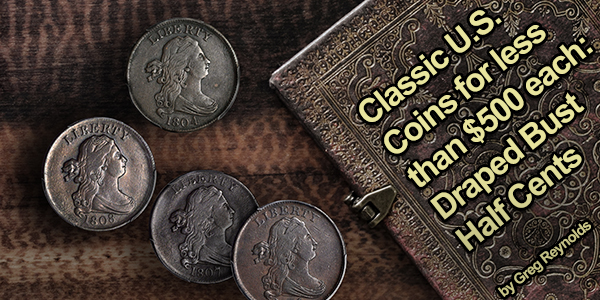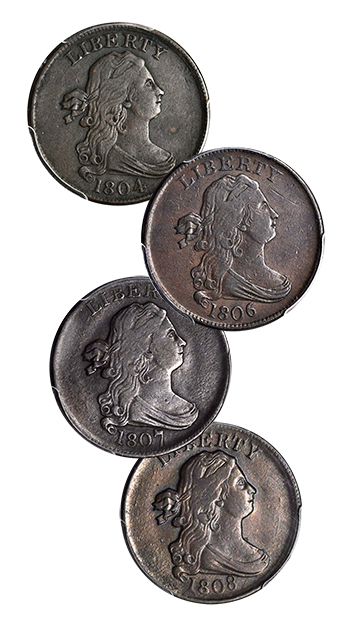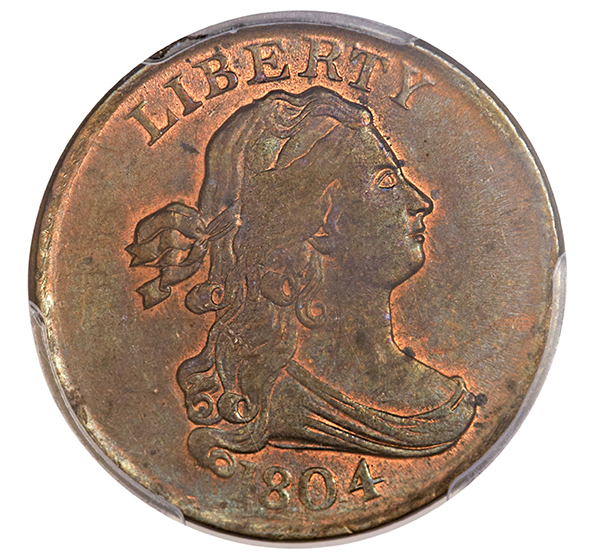
News and Analysis regarding scarce coins, coin markets, and the coin collecting community #329
A Weekly CoinWeek Column by Greg Reynolds ……
Draped Bust half cents were minted from 1800 to 1808. U.S. half cents were first made in 1793 and last produced in 1857. A set of Draped Bust half cents ‘by date’ can be completed without spending as much as $500 on any one coin. This is a short and straightforward series, without extreme rarities. Draped Bust half cents may easily be collected by someone who has never before learned about them.
The Nature of Half Cents
Draped Bust half cents are among the earliest of U.S. coin issues and are usually much less expensive than silver and gold coins of corresponding quality, dating from 1800 to 1808. Draped Bust half cents are excellent values, from historical and logical perspectives. Furthermore, the Draped Bust obverse (front) design is attractive. The ‘1/200’ fraction on the reverse (back) is intriguing.
In 1796, new types of large cents, half dimes, dimes, quarters, and half dollars were introduced with similar Draped Bust obverse (front) designs. The Draped Bust concept is credited to Robert Scot. (Words in blue may be clicked to access references.)
It is often said that the female figure was modeled after Anne Willing Bingham, a very prominent ‘society lady’ in Philadelphia. I am skeptical of a connection between Scot’s female personification of Liberty and Mrs. Bingham. She appears much different in a painting by Gilbert Stuart in the Philadelphia Museum of Art, which is reported to have been finished in 1797.
The first appearance of this Draped Bust concept on U.S. coins was in 1795. I always wondered whether these were in fact struck in 1795. It is generally believed that 1795 Heraldic Eagle $5 gold coins were minted in 1797 or 1798
According to R. W. Julian, the Draped Bust silver dollars that are dated 1795 were very likely to have been really minted in 1795, before the Draped Bust concept was adopted for multiple denominations in 1796. Bob acknowledges that “there is no documentary proof of this. The $30 paid to John Eckstein for plaster models of the silver dollar design in September 1795 is the only [surviving] documentation.” For more than 40 years, Julian has been the leading researcher of the history of the U.S. Mint.
According to Julian, U.S. Mint personnel were focused on meeting demand for large cents and silver dollars and did not have time to prepare for Draped Bust half cents until 1799. “Half cents were struck in 1799 but only a few thousand and 1797 dies were used,” Bob adds.
In diameter, half cents are a little larger than Jefferson nickels. While nickels contain enough nickel to cause the whole coin to be a nickel color, half cents were specified to be entirely copper. They were bright red when struck and tend to tone brown over time, with russet, green or blue tints. Impurities that were in the blanks or floated to the surfaces may contribute to the emergence of other colors, particularly shades of gray. Over a very long period, half cents and large cents will tend to turn green.
Various kinds of cleaning and artificial brightening processes may change the color of a copper coin, as may treatments for corrosion. Well-worn half cents, though, tend to be relatively original. Also, copper coins usually recover rather well from light mild cleanings, though such recovery, if it occurs, can take more than a decade, possibly even a half a century.
Collecting ‘By Date’
Most people who seek more than two Draped Bust half cents collect them ‘by date.’ Effectively collecting them by die variety would require much research and would take many years.
Each coin was struck from a pair of dies. It was not unusual for more than one die pair to be used to strike coins of the same type and date. Veteran early copper enthusiasts tend to collect by die pairing and sometimes focus on additional varieties beyond just pairings, especially die states and minting anomalies.
After a collector builds a set ‘by date,’ he or she may decide whether to further collect the same series by seeking representatives of many die pairings. Most collectors of coins of one denomination or one design type, however, will view a complete or nearly complete set ‘by date’ as being finished and will then focus upon another type of U.S. coins.
 The current discussion is aimed at beginners and intermediate-level collectors, not at people who have extensively studied references regarding early U.S. copper coins. For coins that the prospective buyer regards as expensive, experts should be consulted regarding quality and originality.
The current discussion is aimed at beginners and intermediate-level collectors, not at people who have extensively studied references regarding early U.S. copper coins. For coins that the prospective buyer regards as expensive, experts should be consulted regarding quality and originality.
When collecting ‘by date,’ the issue of stems and ‘no stems’ need not be addressed. For 1804, 1805 and 1806 half cents, there were employed reverse (tail) dies with stems and without stems.
“Missing stems were merely carelessness on the part of workers helping the engraver,” notes R. W. Julian in response to my inquiry.
The stems appear to ‘stick out’ from the wreath at both sides, not far from the bow. These are somewhat noticeable and are not central to the design of the reverse. Most or all of the stemless coins were made with one reverse die, which is of interest to die specialists. Reference guides unfortunately suggest that the stems or lack thereof are important matters. Nevertheless, it seems to me that the stems are very minor components of the design. It is logical for those who collect ‘by date’ to ignore them.
The following dates are needed for a set: 1800, 1802/0, 1804 ‘Crosslet 4,’ 1804 ‘Plain 4,’ 1805, 1806 ‘Small 6’, 1806 ‘Large 6,’ 1807, 1808/7 and 1808. Although the 1804 Spiked Chin is a major variety of the 1804- ‘Crosslet 4,’ rather than an additional date of the year 1804, it is traditionally collected by those who are building sets ‘by date.’ Accidental indentations in an obverse die lead to raised metal on coins that give the impression of a ghoulish extension of Miss Liberty’s chin and the vague impression of a monstrous tongue.
There are often listed 1805 “Small 5” and “Large 5” varieties. There is not enough of a difference in the respective numeral fives for each to be granted the status of a distinct date. The ‘Large 5’ is not that much larger and there are variants of the “Small 5,” which is not very small. Regarding all 1805 half cents, each variant of the numeral 5 appears like it is not of the correct dimensions and is sort of oddly shaped. These ‘5s’ are peculiarities relating to one date, not multiple dates. One 1805 half cent is enough for a set ‘by date.’
In contrast, there is a dramatic difference between the ‘Small 6’ and the ‘Large 6’ 1806 half cents. The ‘Large 6’ is almost gigantic and pokes Miss Liberty’s chest. So, those are two distinct dates of the same year.
A ‘Plain 4’ is obviously distinct from a ‘Crosslet 4,’ a whole different style of the numeral ‘4.’ Traditionally, ‘Plain 4’ and ‘Crosslet 4’ varieties constitute two separate dates of coins of a given year and type, in cases where both were made during that respective year.
The 1808 normal date and the 1808/7 overdate are two distinct dates, though the reason why is not easy to explain. While an ‘8’ was punched over a ‘7’ that had been punched earlier on an obverse die, the overdate aspect is not blatant. The numeral ‘8’ in the ‘normal’ 1808, however, is much different from the numeral ‘8’ in the 1808/7.
Although it may require a magnifying glass to clearly see the overdate aspect, magnification is not required to see that the style and dimensions of these two ‘8s’ are dramatically different. Clearly, the 1808/7 overdate and the 1808 ‘normal date’ are two different dates of the same year.
The 1802/0 overdate is the only 1802. There are no 1802 half cents with ‘normal’ numerals. If we imagine that there were 1802 half cents with ‘normal numerals,’ the 1802/0 would then be a distinct date, as the overdate aspect is very blatant and captures attention.
Being Realistic About Quality and Originality
Given the historical importance and rarity of Draped Bust half cents, $500 is a reasonable amount to spend for a decent piece. When problematic pieces are unintentionally purchased, this is not that much to lose, in the context of early U.S. coins. There are a substantial number of half cents that have sold for more than $100,000 each, and most of those have very noticeable imperfections.
The citations of auction or ‘Internet sales’ of specific half cents in this discussion relate to coins that I have never seen. They are not here being endorsed, praised or criticized.
It is sensible to be realistic and address the reality that collectors of coins dating from the early 1800s are likely to acquire some coins with very apparent and/or hard to detect significant problems. While it makes sense to appreciate the positive aspects of each coin without dwelling upon the negative aspects, education and the truth have value.

As almost all early copper coins have been mistreated to an extent, or have suffered from environmental hazards, collectors should learn at least a little about the physical characteristics of such coins and seek the counsel of experts. Some collectors just ignore the reality that most early copper coins have marked imperfections and many have serious problems.
Early copper coins tend to be characterized by varying degrees of: hairlines from cleaning, corrosion, foreign matter from the atmosphere, and the effects of applied liquids, including oils. Negative experiences in the life of a copper coin contribute to the individuality of each piece.
Given the historical importance and rarity of Draped Bust half cents, $500 is a reasonable amount to spend for a decent coin. When problematic pieces are unintentionally purchased, $500 is not that much to lose. Most pre-1809 U.S. coins cost far more than $500. For less, collectors may buy plenty of VF-20 to EF-45 grade half cents that have very mild imperfections and some very appealing characteristics.
1800
It is satisfying that 1800 is the first year of Draped Bust half cents, the beginning of a century. The United States was then less than a quarter-century old.
A PCGS- or NGC-graded VF-35 1800 could be acquired for under $500. Last month, Stack’s-Bowers auctioned a PCGS-graded VF-30 1800 half cent for $329.
1802/0
There are no half cents dated 1801. The 1802/0 overdate is the key date of the series, and it is expensive. In July 2014, NGC auctioned an AG-03 grade 1802/0 for $381.88. It would be hard to find a better one for less than $500. Some very harmfully cleaned or very much corroded coins with the details of Good to Fine grades might, at times, sell for less than $500, depending upon the extent of the harm that has occurred.
In March 2010, Heritage sold a non-gradable piece in a PCGS ‘Genuine’ holder for $373.75. It would be hard to describe its level of detail.
In September 2011, Heritage sold a coin in an NGC holder with “Good Details, ‘scratches’ and ‘environmental damage.’ It is not really bad. Leading early copper specialists might actually assign an AG-03 grade or possibly a Good-04 grade to it. This coin realized $431.25 at a time when market levels were higher than they are now.
Surely, an 1802/0 can be found for less than $500. Some patience may be required.
1803-1804
A PCGS- or NGC-graded VF-20 to VF-30 1803 could definitely be purchased for less than $500. In May 2013, Heritage sold a PCGS-graded VF-30 1803 for $482.93.
With or without stems in the reverse design, a PCGS- or NGC-certified EF-45 ‘Crosslet 4’ would be likely to sell for less than $500, when available. A certified EF-40 grade can be found for well under $500, if a certified EF-45 grade coin does not emerge in the next several months.
In August 2015, Stack’s-Bowers auctioned a PCGS-graded EF-40 1804-‘Crosslet 4’ half cent, with stems, for $305.50. It is almost certain that an 1804-‘Crosslet 4’ with a ‘Spiked Chin’ could also be purchased for less than $500. In August 2014, GreatCollections sold a PCGS-graded EF-40 ‘Spiked Chin’ half cent for $398.39.
As for the 1804- ‘Plain 4,’ in August 2014, GreatCollections sold a PCGS-graded EF-40 coin, without stems, for $396. Later during that year, in November, this same firm sold a NGC-graded EF-40 coin, also without stems, for $348.21.
Some collectors are not satisfied with a ‘No Stems’ 1804- ‘Plain 4’ and wish for an 1804- ‘Plain 4’ with stems, too. This is a very rare variety. A certified Good-06 to Fine-12 1804- ‘Plain 4,’ with stems, almost certainly could be purchased for less than $500 within twelve months, though some searching might be required.
1805
It is not difficult to acquire an 1805 with a non-large numeral ‘5,’ without stems on the reverse. VF-35 to EF-40 grade pieces sell for less than $500, and a certified EF-45 grade coin might occasionally as well.
The 1805 with stems and the so called ‘Large 5’ is only slight more expensive than an 1805 without stems and non-large ‘5.’ There is some debate as to whether the non-large fives are “small” or ‘medium.” The respective sizes are really similar. A certified VF-30 to EF-40 grade coin could certainly be acquired for less than $500.
It would be difficult to acquire a ‘Stems’ 1805 with a so called ‘Small 5’ for less than $500. In my view, this is a minor variety, anyway. A representative of one of the two just mentioned varieties of 1805 half cents is sufficient for a set ‘by date.’
1806
As indicated already, the ‘Small 6’ and ‘Large 6’ 1806 coins really are two distinct dates of the same year. The collector who seeks a ‘Small 6’ coin with stems may have to settle for a Good-06 to VG-10 grade coin, given a $500 limit. For a date set, however, there is no need to buy an 1806 with stems on the reverse.
It is easy to buy a ‘Small 6’ 1806, without stems, for less than $500. A certified EF-45 grade coin could be acquired, maybe even a certified AU-50 ‘Small 6’ 1806. In early April, Stack’s-Bowers sold a PCGS-graded EF-40 coin for $399.50. Less than a week earlier, though, Stack’s-Bowers auctioned a PCGS-graded EF-45 1806 that was struck from the same pair of dies, which is referenced as Cohen-1.
The PCGS-graded EF-45 coin brought less, $329, than the PCGS-graded EF-40 coin, $399.50. Market levels did not drop substantially during that week. There are multiple other reasons that may explain why this happened. It is important to not take certified grades too seriously.
A certified EF-40 or EF-45 grade ‘Large 6’ 1806 could be bought for less than $500. The somewhat huge ‘6’ is entertaining. About a year ago, Heritage sold one that is PCGS-graded EF-40 and has a CAC sticker ![]() for $376.
for $376.
1807-1808
A PCGS- or NGC-graded EF-40 1807 would be likely to sell for less than $500 in the current market environment. On May 25, 2014, GreatCollections sold a NGC-graded EF-40 1807 for $337.33. In early April, Stack’s-Bowers sold a PCGS-graded VF-30 1807 for $282.
The 1808/7 is very scarce and a large percentage of survivors grade below VF-20. In May 2014, Heritage sold a PCGS-graded VG-10 1808/7 for $425.35. On April 14, 2013, GreatCollections sold a PCGS-graded Good-04 1808/7 for $270.60. Online images suggest that it is pleasant. In March 2013, Stack’s-Bowers auctioned a NGC-graded Fine-12 1808/7 for $470.
More than a few PCGS- or NGC-graded 1808/7 half cents have serious problems. Finding a certified 1808/7 for less than $500 should not be difficult, though collectors should be especially careful in regard to these.
The ‘normal date’ 1808 is very scarce, too. About 12 months ago, Heritage auctioned an NGC-graded EF-40 1808 for $381.88. This price was weak. Generally, such a coin would sell for more than $500. With a $500 per coin limit, a collector may buy a certified Very Fine grade 1808.
Less than a month ago, Stack’s-Bowers sold a PCGS-graded VF-35 1808 for $470. In November 2015, this same firm auctioned a NGC-graded VF-25 1808 for $211.50.
In sum, for less than $500 per coin, a set of Draped Bust half cents ‘by date’ can be completed, with a Spiked Chin 1804 and a ‘Large 6’ 1806. For most dates, PCGS- or NGC-graded VF-25 to EF-45 coins may be obtained without difficulty.
©2016 Greg Reynolds
[email protected]
Recent Articles in this Series on Classic U.S. Coins for less than $500 each:
Classic Head Large Cents | Copper-Nickel Indian Cents | Gem Early Lincoln Cents | Two Cent Pieces | Three Cent Nickels | Standing Liberty Quarters | Walking Liberty Half Dollars | Indian Head Quarter Eagles | Indian Head Half Eagles




